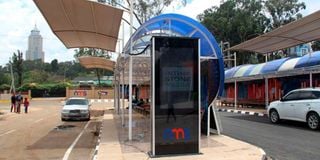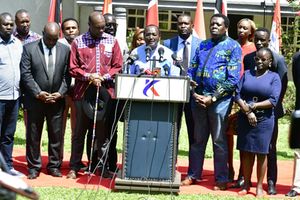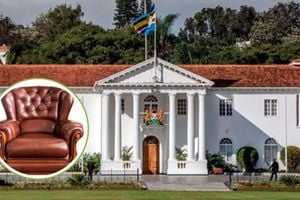
Green Park bus terminus in Nairobi on March 16, 2021.
Kenyans shouldered Sh4.37 billion daily to service public debts in the year to June 2024, but the Sh1.6 trillion annual spend could have all been in vain.
This is due to a cocktail of blunders- designed or out of recklessness by public officials- which have seen the State borrow expensive debts for years, while on the other hand operating structures designed to suck the taxpayer.
From trillions of shillings in costly loans that can’t be traced to any projects, white elephants and stalled projects littered across the country, unnecessary public entities created for political reasons and are now a burden, to billions of shillings entities are paying every year for breaching contracts, the Kenyan taxpayer today is busy paying for the mistakes of past, and current public officials, even though it should never have gotten here.
Public debt
A recent special audit by Auditor-General Nancy Gathungu revealed that the government cannot show projects funded with Sh1.13 trillion of expensive loans it borrowed from external commercial lenders between 2010 and 2021, after the money was used to pay salaries and fund government’s luxuries such as travels and hospitality.
“The special audit established that although the proceeds from the 13 syndicated loans and sovereign bonds totaling Sh1,129,703,842,485 had been received in the Consolidated Fund, there was no evidence that the funding had been applied exclusively to finance development expenditure. It was noted that once the loan proceeds have been received in the Consolidated Fund, the monies are utilised for normal government expenditure that are falling due at the time of receipt of the said funds,” Ms Gathungu noted.
Stalled projects and court awards
When the government has borrowed but the money can’t come through due to its lack of plans, the first casualty has always been projects for which the money was budgeted to fund, which stall as it delays paying contractors and suppliers.
There lacks an exhaustive list of the number of stalled projects across the country, but different reports have estimated their value to be between Sh2 trillion and Sh9 trillion.
Early this year, Treasury tabled a report before Parliament showing that projects already funded to the tune of Sh662.9 billion had stalled, a majority of them being markets, airports, roads, dams and power transmission lines.
Many of the projects were started more than 10 years ago, with some having been initiated even more than 30 years ago and, as audits now reveal, the loser has always been the taxpayer.
The Kenya Airports Authority (KAA), for instance, had to write off Sh4.79 billion it had paid to a Chinese contractor to construct a terminal at the Jomo Kenyatta International Airport (JKIA), and paid the company an additional Sh614.3 million in the year to June 2023 for breaching the contract. “The parties agreed for a full and final payment of Sh614,328,659 and a write off of prepaid amount of Sh4,792,805,325,” the Auditor-General notes.
The Kenya National Highways Authority (Kenha) faces more than Sh22 billion burden on claims from contractors and other parties who have sued it, which if they materialise will be borne by taxpayers.
Awards due to contract breaches cost the national and county governments billions of shillings every year, with billions more paid to lawyers, mostly to fight losing battles.
The abandoned Greenpark bus terminus at Nairobi’s Uhuru Park, which Nairobi Governor Johnson Sakaja decided to do away with in July last year after Sh210 million was used for its construction to push Matatus from operating within the CBD is also another classic case of wastage, making a mockery out of taxpayer money.
The terminus joined a list of projects and programs which despite draining billions of shillings spent from public coffers ended up being abandoned, though their cost has been heavy to taxpayers.
Budgeted corruption
One overlooked form of corruption in the public service has been budgeted corruption, where money is allocated to would-be beneficiaries through items that attract little to no attention from the public.
The clearest example of this is perhaps the revelation by Controller of Budget (CoB) Dr Margaret Nyakang’o that budgetary allocation towards her salary is much higher than her actual salary.
The meaning of this is that someone was pocketing the difference between the budgetary allocation and her actual salary.
The Nation last year investigated an instance where the State had been allocating money yearly to fit lifts and refurbish Bima and Herufi houses. An analysis of allocations to the Treasury over the past financial years showed annual allocations running into millions of shillings towards water reticulation works and installation of CCTV cameras at the two buildings that host the Treasury.
In the year to June 2022, Treasury allocated Sh450 million for water reticulation works at the buildings, a further Sh210 million the following year, sh100 million in the year to June 2024 and has budgeted Sh210 million for the same in the current fiscal year.
When aggregated across the government, these expenditures total billions of shillings each year and are shouldered by the tax payer either through taxes or debt.
Unnecessary and bloated state corporations
President William Ruto’s government has set up dozens of parastatals for mergers, winding up or privatisation as part of measures to reduce the bloated size of State entities which are funded by taxpayers.
Kenya has 349 State corporations, with many performing similar functions thereby draining State coffers. Many of these entities play no strategic role in the economy and are perennially making losses, making their sustenance a major burden to taxpayers.
In April, the State Corporations Advisory Committee (Scac) chairman Philip Mong’ony revealed how MPs and Cabinet Secretaries have for years abused a loopholes to introduce unnecessary entities that now bleed the government billions of shillings every year.
“Oftentimes, private member motions are driven by selfish interests or the proceeds of other interested parties out there. Such bills end up in acts of Parliament and create state corporations without a proper feasibility study and consideration of their financial implications,” Mr Mong’ony said.
Dr Ruto recently said that the government will engage in an elaborate consolidation process that will stop duplicity of functions and wastage.
Funds
Since Kenya gained independence, successive governments have established funds to lend low-cost loans to specific groups. Most of these loans are however never repaid, exerting great pressure on taxpayers to replenish the funds.
The latest in this line of funds is the Hustler Fund, which was Dr Ruto’s flagship fund promise during campaigns ahead of the 2022 polls. He launched the fund in November 2022 to give cheap loans to individuals and business groups.
He had promised to inject Sh50 billion annually into the fund which is formally known as the Financial Inclusion Fund.
However, funding pressures have reduced this allocation to Sh5 billion in the financial year 2024/25. The fund had a high default rate of 27 per cent in 2023, which means that taxpayers are sinking money into a hole from which they can hardly recover anything.
Other funds run by the government to disburse cheap loans to various interest groups include the Universities Fund, Uwezo Fund, Youth Fund and Women Enterprise Fund.












